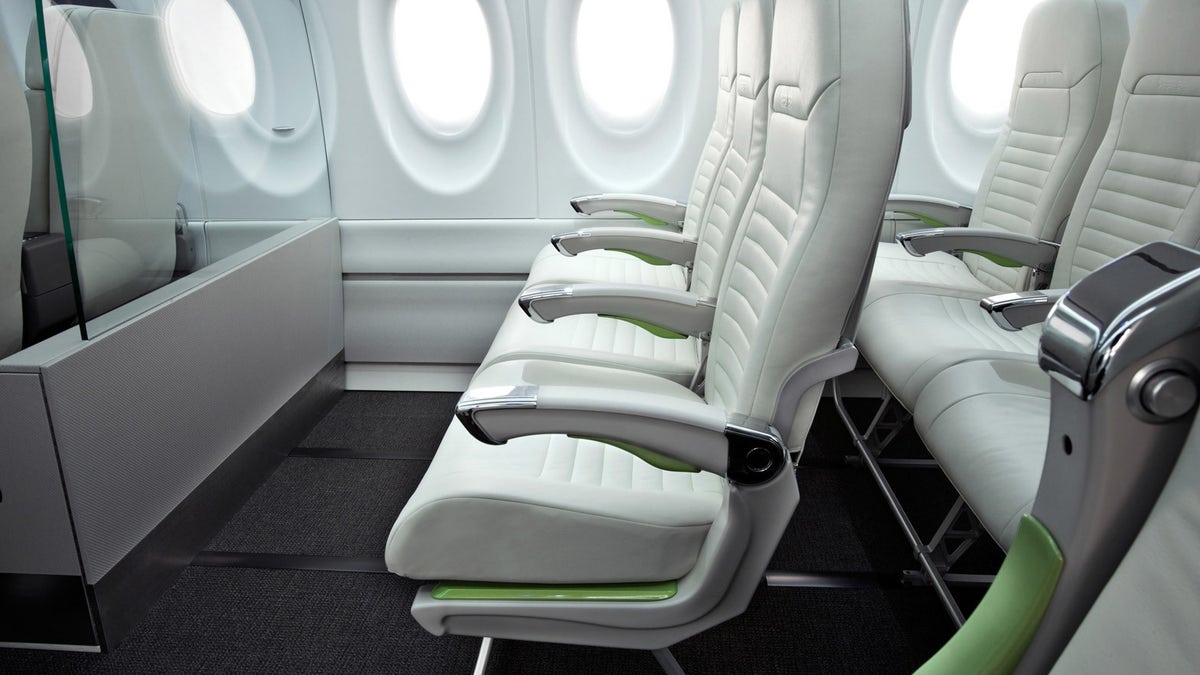
Canadian plane manufacturer Bombardier unveiled a wider seat design on its CS100 aircraft earlier this summer. (Bombardier)
Economy Class — two words that are dreaded by every airline passenger.
Nobody looks forward to the coach class squeeze, but it’s the harsh reality for the great majority of fliers. Although some airlines have done their best to shoehorn us into our seats, two aircraft manufacturers are trending away from that tight fit with their newest planes.
Throughout its history, Airbus has played second fiddle to Boeing. Boeing had about a 60-year head start but the big advantage in being the second to market is that you get the chance to improve your product based on your competitor’s shortcomings.
This is where it becomes important for travelers.
In 2003, Boeing announced the development of the plane that would become the 787 Dreamliner. The clean-sheet twin-engined jet built from carbon fiber composite would be the most efficient jet ever built for airlines, and hundreds were ordered. It wasn’t until 2006 that Airbus responded with a brand new design, capable of matching the 787’s performance.
This new plane — the A350XWB — showed Airbus’ focus not only on what was best for airlines, but also their passengers.
More from TravelPulse
David Hasselhoff Fans Celebrate The Hoff With Upcoming World Cruise
36 Days On Europe’s Great Waterways
Marriott Rewards Introduces Points Bidding
The Magnificent Ancient Bamburgh Castle
5 Must-See ‘Walking Dead’ Destinations
The “XWB” in the A350XWB moniker stands for “Extra Wide Body.” Every inch counts when you’re on a long international flight, and Airbus designed their plane to be just over seven inches wider than Boeing’s 787. Boeing showcased the 787 with 8 seats per row, but said airlines could fit up to nine.
Most have opted to add that extra seat when configuring their planes, making the economy seat width a little less than 17 inches. However, the extra width of the A350 allows nine seats per row, which maximizes revenue while also giving passengers 18 inch-wide seats. An inch doesn't seem like much, but it makes a huge difference on long flights.
Canada’s Bombardier has brought wide seats to the short-haul game with their new C Series aircraft. You may have flown one of their tiny Canadair regional jets, but the C Series holds nearly as many as the popular Airbus A320s and Boeing 737s. Most importantly, seats are significantly wider.
The rows only have five seats across, with window and aisle seats that are 18 inches, and the middle seats are 19 inches, which is unmatched in any other economy class. The extra width may make the middle seat the most coveted by passengers.
Swiss International Airlines was the first airline to add the C Series to their fleet, and put it into service in mid-July. Here in the States, we’ll be seeing them flying for Delta Air Lines, which ordered 75 of them, with options for 50 more.
Right now, Qatar Airways is the only airline flying the A350XWB to the U.S. (Doha to Boston), but Singapore Airlines will soon be flying it from Singapore to San Francisco. American and Delta each have A350s on order as well, and other international carriers will likely be adding U.S. destinations in the coming years.
For travelers, it’s important to pay attention to what type of plane you’ll be on, if you want to be as comfortable as possible. As more of these planes enter service around the world, I would certainly seek these two types of planes out when buying a ticket.
